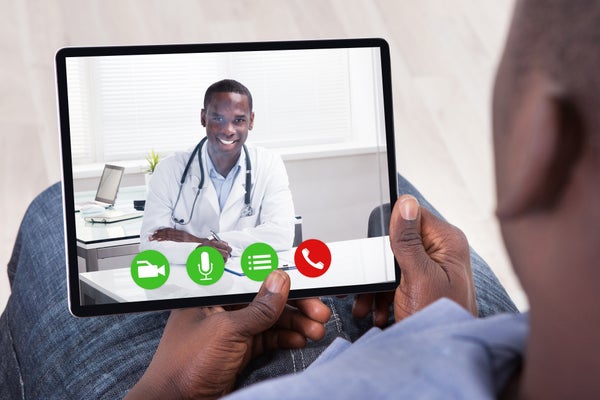This article was published in Scientific American’s former blog network and reflects the views of the author, not necessarily those of Scientific American
Telemedicine may finally get its time in the clinical spotlight. Along with billions in emergency funding, Congress recently loosened restrictions on how telemedicine can be reimbursed and implemented for Medicare patients.
As a physician, the most interesting part of this legislation—outside of how to be reimbursed for services—is what type of platform I can use to see patients. The legislation now allows physicians to see patients through a telephone with “audio and video capabilities that are used for two-way, real-time interactive communication”; read: doctors now can use their smartphone.
This sounds progressive, but the problem is that telemedicine isn’t really as straightforward as picking up my smartphone and FaceTiming my patients.
On supporting science journalism
If you're enjoying this article, consider supporting our award-winning journalism by subscribing. By purchasing a subscription you are helping to ensure the future of impactful stories about the discoveries and ideas shaping our world today.
In many states, telemedicine is viewed as a parallel form of medicine, with its own licensing procedure.
Kristin Budde, MD, MPH, the director of digital health for Yale University’s Department of Psychiatry (and also my wife), explains: “All states require you to have a license to practice medicine, but some states—like New Mexico, for example—have separate, expedited licenses for out-of-state physicians who want to practice telemedicine.”
“In the past, the main driver of these telemedicine laws has been distance or access to care,” Budde says. “Rural states, on average, are more open to telemedicine services because they have greater provider shortages.”
Reimbursement—how a clinic gets paid for services—has also limited the adoption of telemedicine. Many private insurance companies reimburse telemedicine visits at only a small fraction of an in-person office visit. So even if a telemedicine visit requires that a clinician speaks with a patient for an hour, reviews new laboratory results, or consults another clinician, she can only bill (if at all) for a small part of that service.
Some states have legislated against this bias. New Mexico passed a telemedicine parity bill that requires private insurance companies to reimburse for telemedicine services the same as an in-person medical visit.
An important nuance is that the new federal laws do not require physicians to use or even offer telemedicine services. The laws just making it easierfor Medicare patients to access and (if the details are worked out) for physicians to bill for telemedicine services.
No clinic is required to provide telemedicine services—even if doing so might decrease the risk of them or their patients spreading COVID-19. Hospital systems, group practices and small clinics are independent businesses that decide what services to offer based on many factors. Although reimbursement is a primary concern, it is not uncommon for a hospital system to be bureaucratically hamstrung just deciding which telemedicine platform to use—before seeing a single patient.
To learn how Congress’s new legislation was working on the ground, I FaceTimed my friend Richard Rigby, MD, a primary care physician at Providence Medical Group in Portland, Oregon.
COVID-19 testing kits became available in Rigby’s clinic on March 12, and his group assessed their first patient that very day. Notwithstanding social distancing efforts, his practice is busier than normal.
I asked Rigby if he was using telemedicine to screen or evaluate patients for the new coronavirus, especially patients with high-risk conditions like lung disease, heart disease or uncontrolled diabetes.
“Oh no, unfortunately not,” Rigby told me, “We’re trying to.” (A week later he told me that, in an effort to keep patients and staff safe from COVID-19, his clinic has moved all scheduled appointments to telephone calls. The day before an appointment, nursing staff will call the patient and administer a COVID-19 screening questionnaire. If required, staff will arrange an in-person evaluation or a higher level of medical care for the patient. Rigby’s clinic is exploring ways to add video capability to these clinical interactions. The clinic does not currently have the ability to gather data like blood pressure, heart rate or temperature over the phone.)
In the original conversation, Rigby reminded me that everyone acknowledges that—perhaps now more than ever—telemedicine would be an ideal way to see patients. But many practices (like his) simply don’t have the capability to perform telemedicine visits.
Such a visit is—at minimum—a video chat with your physician. Although your clinician probably has the capacity to do this (more than 85 percent of U.S. adults have a smartphone), it’s much less likely that you or your clinician have the tools to fully evaluate you for COVID-19 symptoms.
Medicine is more than just a conversation; it is a conversation about medical data. Outside of your clinical history, if you’re worried you might have COVID-19, your clinician needs to measure your temperature or blood oxygenation with a thermometer or pulse oximeter. To gather this data, you need to have a digital thermometer or pulse oximeter that can collect and transmit this data to the physician.
“We’re just not set up to do something like this, even though we’d like to,” Rigby explained, as he returned to his busy waiting room.
Federal regulations are now changing, but at this time changes are limited to Medicare patients, who are 65 years or older. State and private insurance company regulations that also dictate the type of care we receive may not have changed. Further, even if clinicians want to provide telemedicine services, they may not have the tools to do it effectively or a way to coordinate those telemedicine visits.
But necessity is the mother of all invention, so there is hope that the system will adapt.
“Now that infection control is on everyone’s minds,” Budde said optimistically, “I expect we’ll see a rethinking of telemedicine generally.”
Further Reading
Using FaceTime for Telemedicine. HIPAA Guideline for Healthcare Video Visits. Published by Simple Visit.
Read more about the coronavirus outbreak here.
